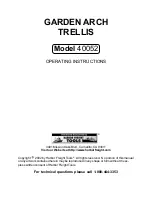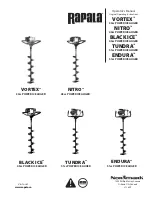
Operating Modes:
You may operate your Deco 250
™
in three different ways:
•
Stand Alone Mode
- The unit will react to sound, chasing through
the built in programs. You may also use the optional MINI/C Remote
to control a blackout function.
• Master/Slave Mode
- This mode allows you to daisy chain up to 4
units together to get a synchronized light show that will react to sound
and chase through the several built in programs.
• DMX Mode
- This function will allow you to control each individual
fixtures traits with a standard DMX 512 controller such as the LSC
®
Show Designer.
™
Note: Sound Acitve and Master-Slave operation require sound to acti-
vate! If the units do not move adjust the volume sensitivity knob on the
rear of the fixture.
Note: To conserve lamp life, the unit will automatically turn off the lamp
when the fixture has been inactive for longer than 60 seconds. This is
not a malfunction and will aid lamp and unit longevity by decreasing
heat.
Stand-Alone Operation (Sound Active):
This function allows a
single unit to run to the beat of the music or run any of the built in pro-
grams. Only use this function when running a single unit, or when run-
ning several units as individuals.
1. To activate the Sound-Active mode or a built in program, refer to
the Special Function list on page 15.
2. The unit will now react to the low frequencies of music via the
internal microphone. The unit is preset to activate at a certain
sound pressure level. Occasionally the unit will not react to certain
high pitch sounds.
3. The optional
MINI/C Controller
may be used with this mode to
control stand-by (blackout).
Master-Slave Operation (Sound Active):
This function will allow
you to link up to 4 units together and operate without a controller or with
the MINI/C. The units will react to sound. In Master-Slave operation one
unit will act as the controlling unit and the others will react to the control-
ling units programs. Any unit can act as a Master or as a Slave.
Deco 250™
Operation
©
American DJ
®
- www.americandj.com - Deco 250™ Instruction Manual Page 8
©
American DJ
®
- www.americandj.com - Deco 250™ Instruction Manual Page 7
Deco 250™
Operation
1. Using standard XLR microphone cables, daisy chain your units
together via the XLR connector on the rear of the units. Remember
the Male XLR connector is the input and the Female XLR connec-
tor is the output. The first unit in the chain (master) will use the
female XLR connector only - The last unit in the chain will use the
male XLR connector only. For longer cable runs we suggest a
terminator at the last fixture.
2. Follow the chart on page 15 for proper unit dipswitch settings.
3. The optional
MINI/C Controller
may be used with this mode to
control stand-by (blackout).
4. After all the units settings have been set and are plugged in, they
will begin to run to sound. If there is no sound present the units
will blackout to preserve and extended lamp life.
Universal DMX Control:
This function allows you to use a univer-
sal DMX-512 controller such as the LSC
®
DMX Operator™ or Show
Designer.™ to control the textured glass gobo wheel, the color arm,
and mirror kit. Using a DMX controller will allow you to customize pro-
grams and expand functionality. Operating through a DMX controller
gives freedom to create unique programs tailored to oneʼs individual
needs.
1. The Deco 250™ uses 3 DMX channels. Channel 1 controls
the textured glass gobo wheel, channel 2 controls the color
arm and channel 3 controls the dichric mirror. See page 14 for
detailed description of the DMX traits.
2. To control your fixture in DMX mode, follow the set-up proce-
dures on pages 9 - 11 as well as the set-up specifications that are
included with your DMX controller. Assign a DMX address to the
unit.
3. Use the controllerʼs faders to control the various DMX fixture traits.
4. This will allow you to create your own programs.
5. For help operating in DMX operation consult the manual included
with your DMX controller.
6. For longer cable runs (more than a 100 feet) use a terminator on
the last fixture.



























